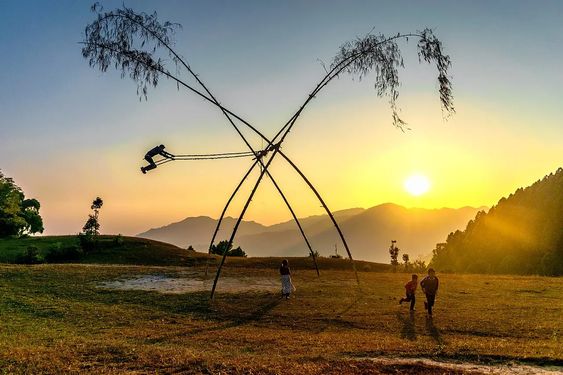Chhath Parwa, also known simply as Chhath Puja, is a unique and ancient Hindu festival dedicated to the Sun God (Surya) and his sister, Chhathi Maiya. Celebrated primarily in the Indian states of Bihar, Jharkhand, Uttar Pradesh, and in Nepal’s Mithila region, Chhath is a deeply spiritual festival that marks the power of nature and the unwavering faith of its devotees.
Origins and Significance of Chhath Parwa
The roots of Chhath Parwa trace back to the Vedic period, where sun worship held immense importance as a source of life, energy, and healing. Surya, the Sun God, is worshipped as the supreme deity who nourishes and sustains life on Earth. Devotees seek blessings from Surya and Chhathi Maiya, asking for health, prosperity, and the well-being of their families.
The significance of Chhath is not limited to religious faith alone; it is also deeply intertwined with environmental reverence. The rituals are performed by rivers, ponds, and other water bodies, reflecting the importance of nature and water resources. The festival beautifully conveys the interconnectedness of humans with the environment.
The Four-Day Ritual of Chhath Parwa
Chhath Parwa spans four days and involves strict discipline, devotion, and purity, with each day marked by specific rituals:
- Nahay Khay (First Day): The first day begins with devotees taking a holy dip in the nearest river or pond to purify themselves. They then bring water back to their homes to prepare prasad (offering) and cook a pure, vegetarian meal. This marks the beginning of a fast and self-purification.
- Lohanda and Kharna (Second Day): Devotees fast from sunrise until sunset. In the evening, they prepare prasad, typically made from rice pudding, jaggery, and chapati. After offering this to the Sun God, they break their fast. After this meal, a 36-hour nirjala (waterless) fast begins, one of the most intense and testing parts of Chhath Parwa.
- Sandhya Arghya (Third Day): This is the most vibrant day of Chhath, as devotees gather at the banks of rivers or ponds during the evening to offer ‘arghya’ (offering) to the setting sun. With trays filled with fruits, vegetables, and other offerings, they pray and seek blessings while performing rituals amid chants and songs. This day also includes a fascinating aspect: people form community bonds as they support each other in their shared devotion.
- Usha Arghya and Parana (Fourth Day): On the final day, devotees return to the riverbank to offer their prayers to the rising sun, completing the cycle of evening and morning worship. With the offering of ‘arghya’ to the morning sun, the fast comes to an end. Devotees then break their fast with the prasad they prepared.
Unique Features of Chhath Parwa
Chhath is distinct among Hindu festivals because it does not involve elaborate idol worship or temple rituals. Instead, the worship is entirely dedicated to nature and natural elements, particularly the sun and water, symbolizing a direct connection with the divine. Devotees believe that by offering sincere prayers to the Sun God, they can receive healing, prosperity, and happiness for their families.
Additionally, Chhath Parwa is an inclusive festival celebrated with strong community participation. Families, neighbors, and friends come together to create a deeply supportive and uplifting environment. The festival also emphasizes cleanliness, environmental conservation, and personal discipline, which are key to the spirit of Chhath.
The Cultural Importance of Chhath Songs and Folk Music
No celebration of Chhath Parwa is complete without its soulful folk songs, which are passed down through generations. These songs are a way of storytelling, passing on values, prayers, and a sense of tradition from one generation to another. Sung in Bhojpuri, Maithili, and other local dialects, Chhath songs add a special layer of cultural richness and connect communities across villages, towns, and cities.
Chhath Parwa in Modern Times
In recent years, the essence of Chhath Parwa has spread beyond its traditional regions, with devotees across India and the globe observing it. Migrants from Bihar and Nepal, wherever they settle, bring with them the customs and traditions of Chhath, celebrating it with the same vigor and dedication. Despite the distance, these communities recreate the riverbanks, set up rituals, and come together to celebrate Chhath just as they would back home.
This adaptability shows the power of Chhath to unite people and inspire devotion. Furthermore, environmental initiatives around Chhath Parwa, like river clean-ups and plastic-free rituals, highlight the festival’s role in promoting eco-conscious practices.
Conclusion
Chhath Parwa is a festival that beautifully embodies the values of faith, resilience, purity, and environmental respect. It serves as a reminder of the simple joys and strength in unity, the importance of nature, and the benefits of disciplined living. Through their dedication to the Sun God, devotees celebrate the life-giving force of nature while passing down a legacy of faith and culture to future generations.
May Chhath Parwa continue to be a source of light, hope, and blessings for all who celebrate it.




XMC.PLsays:
You have the gift of turning abstract thoughts into something tangible, allowing the reader to grasp concepts with clarity.